|
The extensive social infrastructure constructed during Japan’s period of high economic growth has, in recent years, begun to deteriorate, leading to major problems for society. A particularly urgent issue is fatigue in the concrete decks of road bridges. In particular, companies operating expressway have been forced to allocate most of their major renovation budgets to work on concrete decks.
Fatigue continues to be an issue with concrete structures. Efforts to resolve
the problem include studying how to apply Miner’s rule to beams and other
members. Wheel loading test machines capable of generating cyclic moving
active loading on a road have been developed and applied to various types
of concrete deck. Recently, a three-dimensional nonlinear finite element
analysis method has been developed by incorporating nonlinear material
models for high cyclic loading. Generally, though, research in this field
has taken a structural engineering approach. On the other hand, a current
problem with concrete decks is extensive damaged caused by the use of salt
(NaCl) as a de-icing agent. Fatigue caused by traffic further accelerates
the damage, resulting in visible damage and diminished structural performance.
Resolving these problems requires a concrete-engineering approach.
This report summarizes topics related to fatigue studies of concrete structures
that have been discussed in the past two years by this subcommittee established
by the JSCE Concrete Committee. The report describes the activities of
two working groups (WGs): the WG for elucidation of mechanisms (WG1) and
the WG for performance evaluation (WG2).
WG1 has examined fatigue failure mechanisms relating to concrete and steel reinforcement and the bonding between them, as well as fatigue mechanisms relating to reinforced concrete members. The WG also proposed a technique for assessing fatigue damage in reinforced concrete structures and described examples of concrete foundations for wind turbines, etc.
On the other hand, WG2 examined concrete road bridge decks and discussed
ways that their quality and performance may be maintained at each stage
of their life cycle: design, construction, and maintenance. The WG argued
that performance evaluations, particularly those of the entire superstructure
(main girder, concrete deck, waterproofing system, and pavement), can lead
to improved durability and fatigue resistance of concrete decks in harsh
environments, such as those in which de-icing agents are used. The report
of this part was based on a result of discussions among experts in concrete
decks and pavements.
The above clarifies the outstanding research and technological achievements being made in this field. Significantly, this work by the Concrete Committee has been carried out with the involvement of many junior and mid-level researchers and engineers. The committee is expected to continue studying fatigue in concrete structures and developing technologies for resolving the issue in the years to come.
The working group for elucidation of mechanisms (WG1) was established to
determine the extent of current knowledge about concrete fatigue. The results
of many fundamental studies on fatigue failure in reinforced concrete structures
were collected and analyzed. A second purpose was to discuss appropriate
methodologies for evaluating fatigue damage in consideration of the latest
developments in numerical analysis technology. Three workshops were held
in the group’s first year. In the second year, several research topics
were selected for particular focus and studies were carried out. The results
of these studies have been compiled in Volume II.
Firstly, current methods of evaluating fatigue damage in reinforced concrete
structures were examined and several research questions were raised from
this process. What is the phenomenon of fatigue in reinforced concrete
structures? What actions cause fatigue in structures? How does the response
of individual members affect overall structural performance? After these
questions were raised, issues related to appropriate methods of evaluating
fatigue in structures were discussed.
This discussion identified the following issues concerning fatigue mechanisms.
a) General issues relating to the modeling of cyclic actions
Specifically, there is a need for more studies
to develop reasonable modeling methods that can take into
account
the time-history of cyclic actions and appropriate methods of modeling
the cyclic actions caused by
force transferred
from vehicles, etc.
b) General issues relating to the evaluation of member responses that
are generated in structures by cyclic actions
Specifically, there is a need to discuss the following:
methods of estimating three-dimensional response
stress
histories associated with rotation of the principal stress direction; further
development of non-linear
constitutive models;
and indexes and techniques to quantitatively evaluate the amount of damage
to
materials or their degree of failure.
c) Issues relating to the verification of RC decks of road bridges
subjected to moving loads
In particular, it is necessary to consider the
intensity and frequency of loads and uncertainty regarding the
loading
position (wheel tracking position).
On the subject of the maintenance of RC structures, the following issues
were identified.
a) A method should be established for evaluating load-bearing capacity
after some damage has occurred.
b) A technology needs to be developed to determine whether fatigue has been caused by the combined
effect of cyclic loads and environmental
action, or by the effect of one alone.
Secondly, to clarify the mechanism of fatigue in reinforced concrete, academic
research results concerning fatigue in concrete, steel reinforcement, and
the bond between concrete and steel reinforcement were collated and analyzed.
An attempt was made to summarize issues concerning the effects of load
amplitude and material deterioration (freezing-thawing action, alkali-silica
reaction (ASR), and the presence of water). These must be taken into account,
but so far they are not well understood. Further, the impact of corrosion
of the steel reinforcement on fatigue in reinforced concrete was investigated.
The investigation and analyses suggests that further experimental data relating to reinforcing bar fatigue under both tension and compression (reversal cyclic loading) are still needed. Also, requirements for further experimental studies relating to fatigue in the bond between concrete and reinforcing bars, especially considering loading rate, reinforcing bar corrosion, and the effect of liquid water, were pointed out.
In addition, we also organized the results of the latest experiments and
numerical analyses. First, reinforced concrete slabs subjected to fatigue
damage were selected as examples of dynamic non-linear response analysis.
Figure A shows evaluations of various influencing factors (strength of
concrete, loading speed, boundary conditions, etc.) using sensitivity analysis.
This study revealed much information about fatigue in reinforced concrete
structures that would have been difficult to obtain only through experiments.
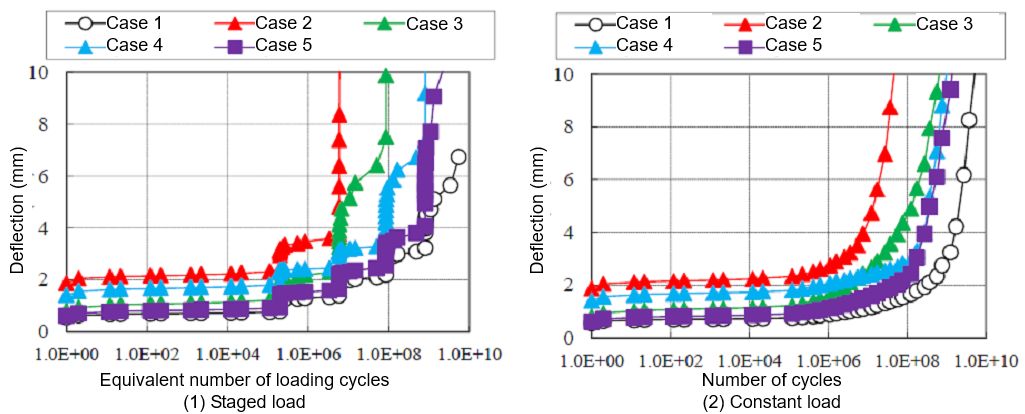
Fig. A. Examples of deflection analysis of RC slabs under moving loads obtained by 3D non-linear FEM
Moreover, the Actual structures are affected by deterioration caused by
environmental conditions and material properties, as well as by the effects
of fatigue. Figure B shows the results of studies that evaluated the progress
of deterioration due to chloride attack or ASR; those coincide with fatigue
damage in RC slabs. The study focusing on chloride attack suggests that
the performance of an RC slab is influenced by the history of environmental
action leading up to corrosion, as well as by the chloride ion content
in the concrete and the amount of rebar corrosion. Another study evaluating
the failure of reinforced concrete due to fatigue caused by environmental
and meteorological actions and the effect of water in cold climates is
also introduced. A special experimental study that examined the effects
of water and wheel speed is listed together in the report. Further, information
about evaluating damage caused by fatigue in RC members that had been repaired
and strengthened was revealed.
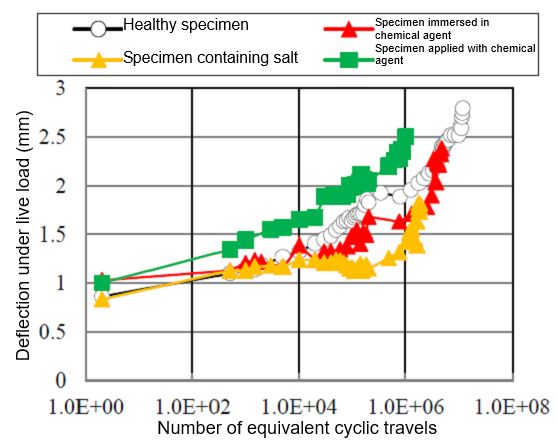
Fig. B Wheel load travel test results under different conditions of corrosion
The phenomenon of fatigue must be considered in other types of structures, not only in road and railway bridges. A pioneering study which elucidated the damage process and failure mode due to fatigue in the RC foundation of a wind turbine (Fig. C) is presented in our report. An S-N curve shows the limit state of the foundation supporting the wind turbine tower when a repetitive load of constant amplitude is applied in a single direction. As an index, the secondary invariant of average deviatoric strain of the concrete at the foundation connection was used.
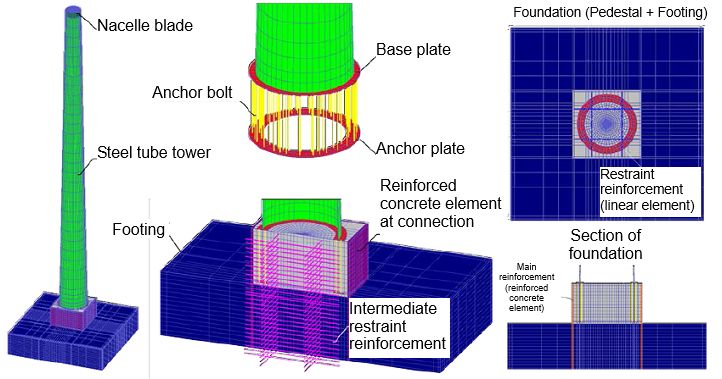
Fig. C Example of damage process and failure mode due to fatigue at the connection in the reinforced concrete foundation of a wind turbine
Lastly, a technique which enables us to evaluate structural damages in
a consistent way at any timing, rather than combining evaluations of failure
at ultimate load and fatigue failure, was proposed by the working group.
Although it is difficult to measure the changes in residual bearing capacity
experimentally, a recent development in numerical analysis technology makes
it possible through simulations. To verify the proposed method, a non-linear
finite element analysis was performed for RC beams and slabs. However,
this proposal for determining residual bearing capacity did not give the
expected results for an RC beam that suffers flexural failure; this is
possibly because the effect of concrete fatigue damage on bearing capacity
is relatively small. In contrast, the reliability of the proposed method
was proved in the case of an RC slab that suffers shear failure (Fig. D).

Fig. D Simulation of residual bearing capacity of reinforced concrete slab
under the action of wheel load
We thus have decided to continue the examination of the applicability of
this method to other requirements of structural performance, such as serviceability.
The WG2 studied the design, construction, and maintenance of the reinforced concrete decks of road bridges with the aim of maximizing their overall performance. Information about recent cases of damage to reinforced concrete decks was collected and measures to prevent such damage were studied. Damage caused by fatigue in road bridge decks has been a problem since the 1960s. Grid-like cracking is noticeable on the decks of road bridges designed to the old standard (Photo A). Revisions of the standard have dealt with the problem of fatigue damage by increasing the minimum slab thickness and the amount of steel reinforcement. However, in addition to increasing the deck strength, the WG suggests improving the design of the girders in order to prevent damage and deterioration. For instance, by taking the number of main girders and their spacing into account along with the vehicle loading positions during the design stage, it is possible to considerably reduce damage to the slabs (Fig. E).
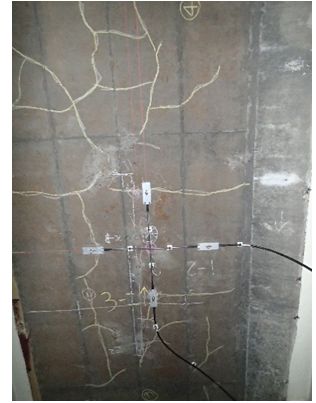
Photo A Grid-like cracking on underside of deck
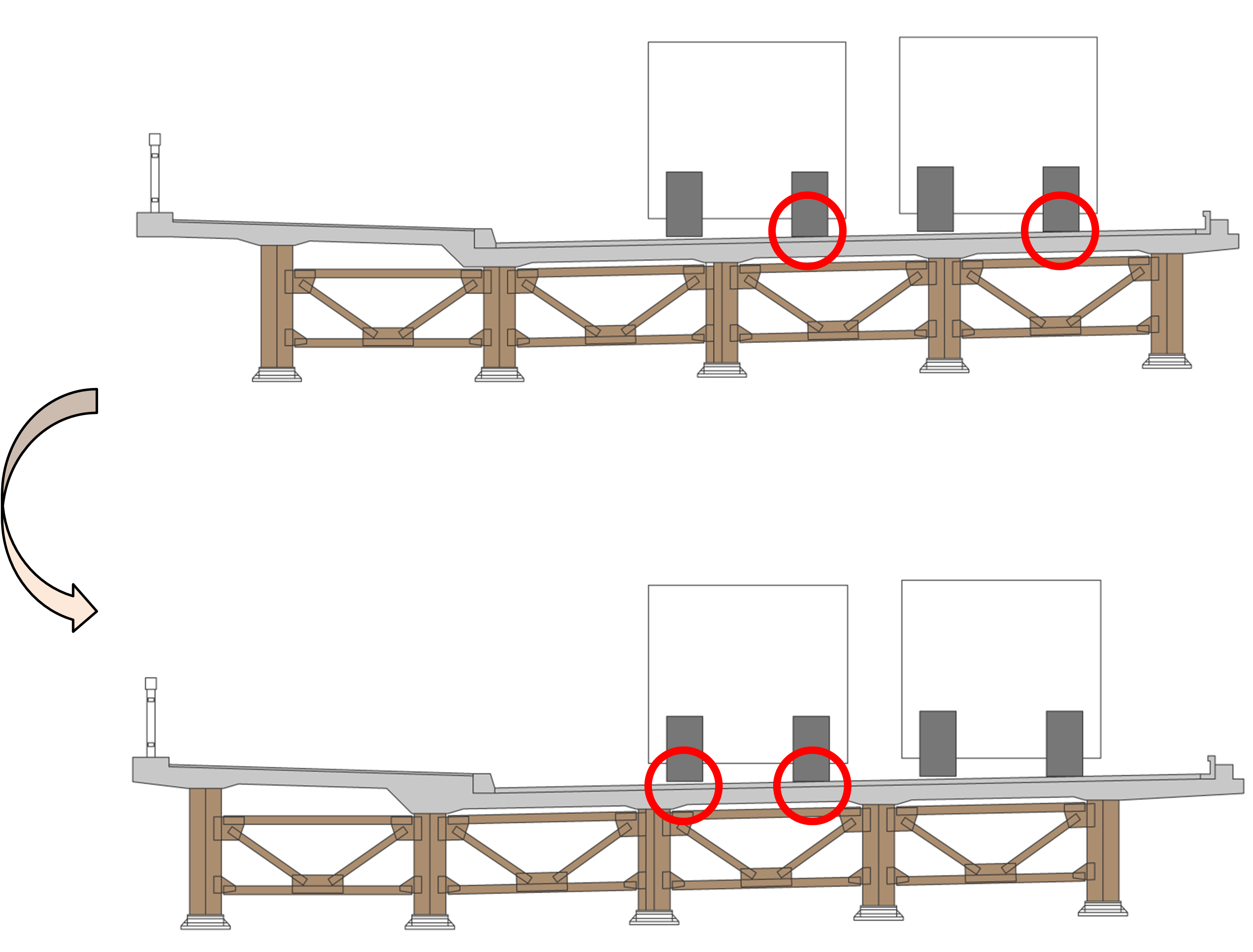
Fig. E Reduction in response value by revised main girder layout (upper: conventional layout; lower: proposed layout)
Fatigue failure due to heavy traffic loading is not the sole cause of damage
to decks. Concrete on the upper surface of a reinforced concrete deck can
fracture and become pulverized (Photo B).
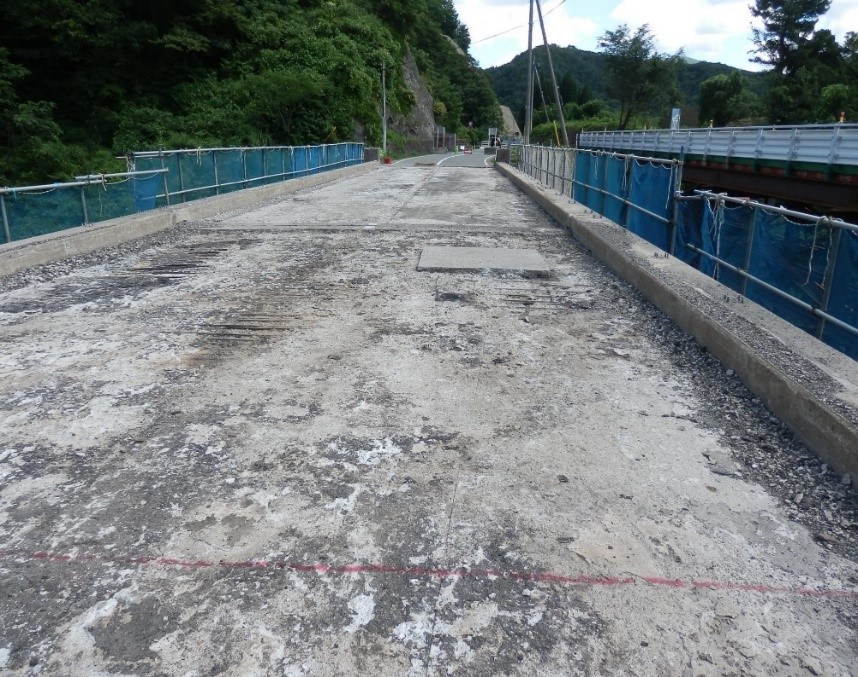
Photo B Pulverized concrete on reinforced concrete deck
The mechanism by which concrete becomes pulverized has not been clarified,
but the phenomenon is mostly seen in environments in which anti-freeze
agents are used. Previously, a clear one-to-one relationship was thought
to exist between various actions on a deck and deterioration (left side
of Fig. F). However, anti-freeze agents not only establish a new form of
deterioration – salt damage – but the action becomes more complicated to
elucidate. Therefore, traditional materials design methods may not be able
to prevent deterioration.
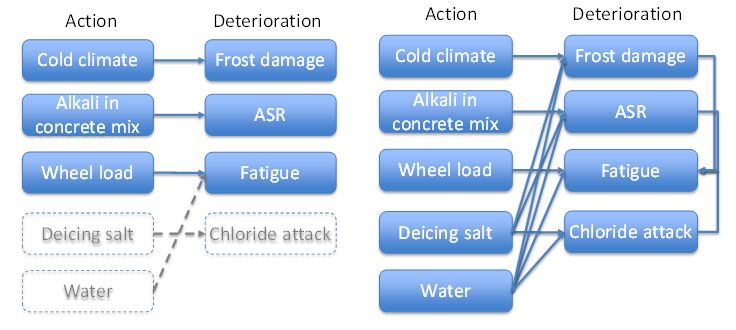
Fig. F Relationship between assumed actions and deterioration in deck design (left: conventional understanding; right: environment with anti-freeze agent)
To elucidate the mechanism as a step toward preventing pulverization, a test deck was constructed on a reconstruction road in the Tohoku region of Japan. Measures were implemented against all possible forms of deterioration by considering the combined action of salt in the anti-freeze agent and alkali ions. Furthermore, redundant measures were applied, resulting in a system that prevents deterioration (Fig. G). Fly ash was used in the concrete to inhibit salt damage and the alkali-silica reaction (ASR).
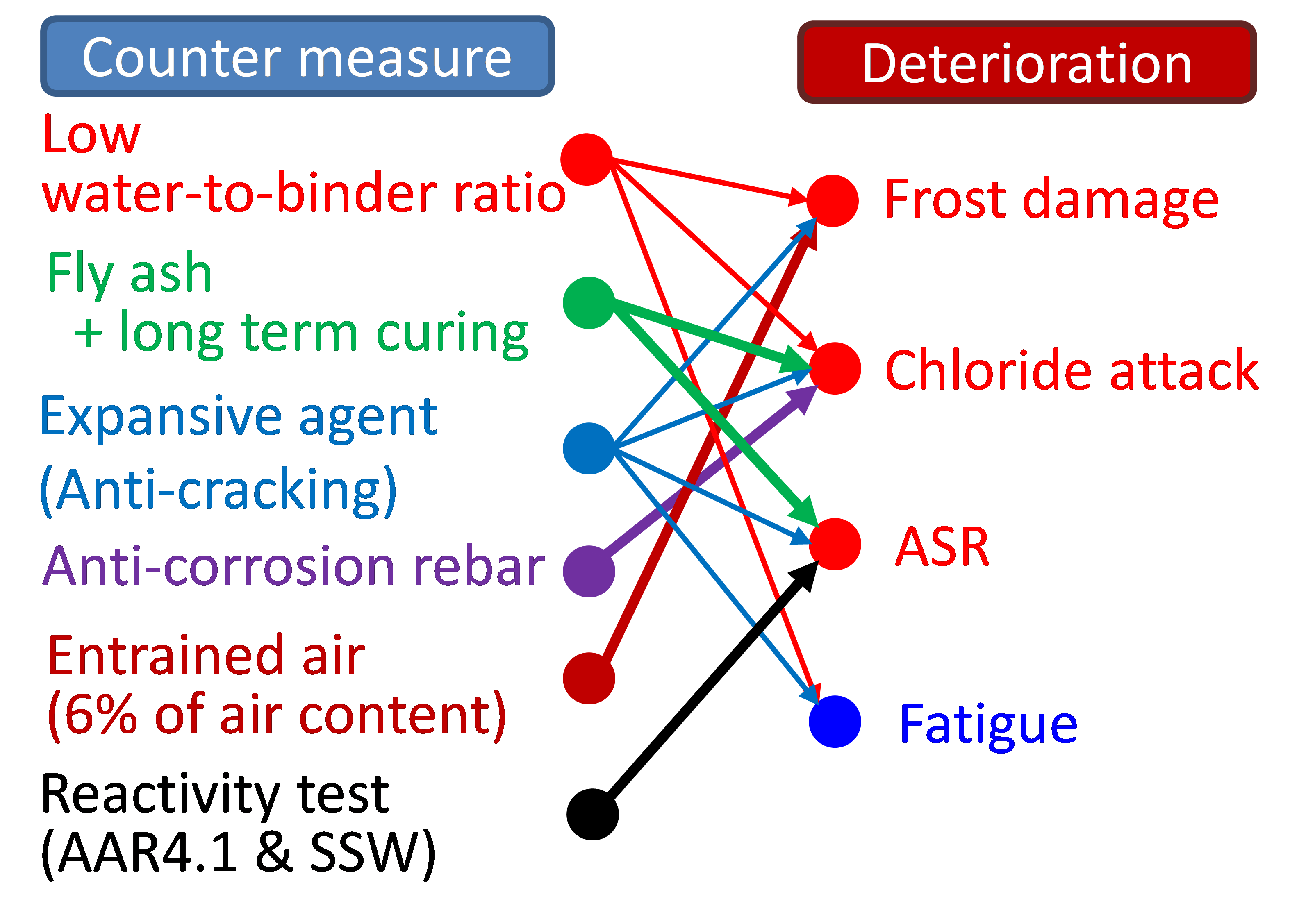
Fig. G Example of highly durable deck design by redundant protection and
use of admixture
Photo C shows a case of potholes in the asphalt pavement covering a deck
slab. Potholes develop when the waterproofing layer between the slab and
the asphalt pavement becomes detached. Because some types of finishing
agent used during deck construction can reduce the bonding force with the
waterproofing system, all materials should be evaluated for compatibility.
Moreover, if water collects within the asphalt layer, potholes can easily
develop. The water easily enters the slab through gaps in the layer and
may collect under the layer (Photo D). Water collecting on the upper surface
of the reinforced concrete deck significantly reduces fatigue resistance.
Hence, decks should be constructed so that they cannot collect water.
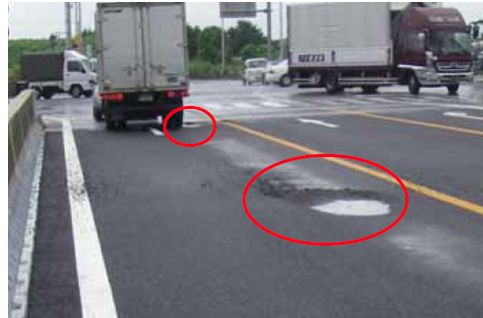
Photo C. Potholes
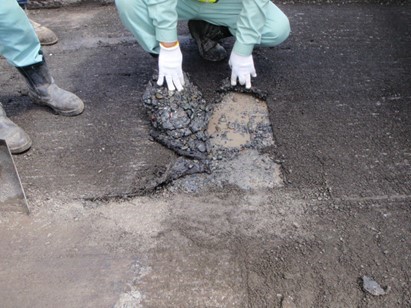
Photo D. Water collects under waterproofing layer
Proper drainage is critical for preventing water from collecting and requires proper planning and upper-surface finishing of a deck to a flat and smooth finish. However, when the surface is manually finished, as is currently done, the surface may be uneven, allowing water to collect after rain (Photo E). To prevent this, the WG has developed technologies to improve the flatness of the surface. Photo F shows a simple finishing machine developed by the WG. Used in the finishing processes, the machine reduces the finishing error to about ±2 mm.
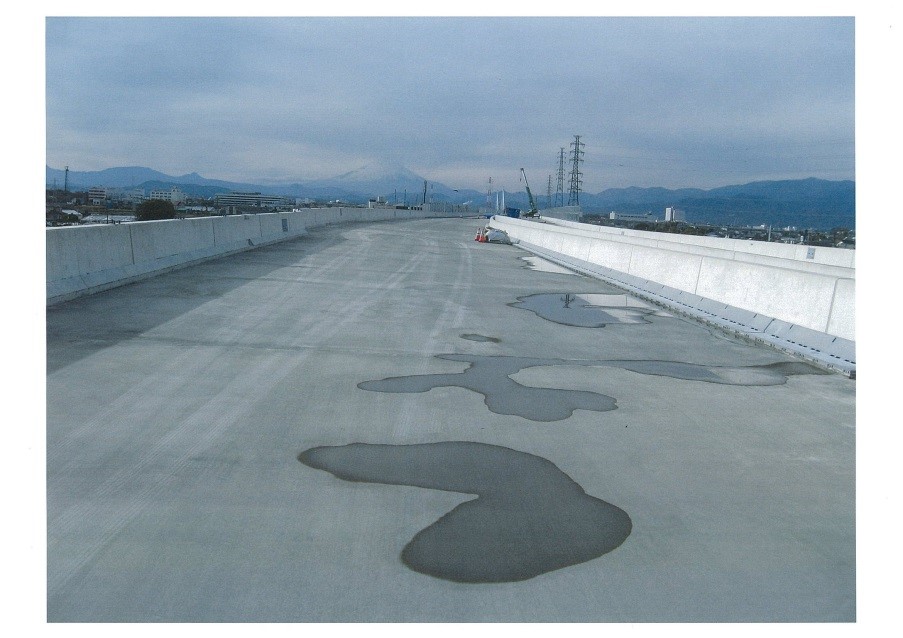
Photo E Water collects on deck after rain
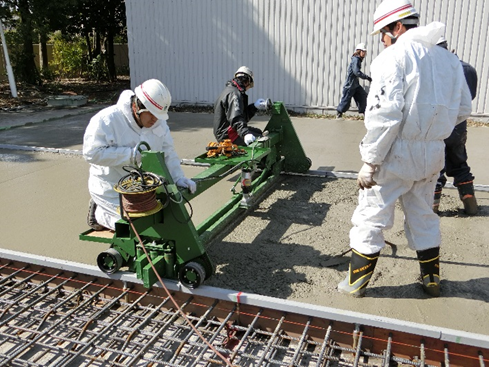
Photo F Simple finishing machine prototype ensures flatness
A concrete deck does not function in isolation. When constructed together
with a pavement and waterproofing layer, it allows for the smooth travel
of wheel loads. Hence, concrete slabs should be treated as complete systems.
To avoid problems at the interfaces between components of a deck system,
a means for transmitting information between construction workers in different
trades is required.
|












